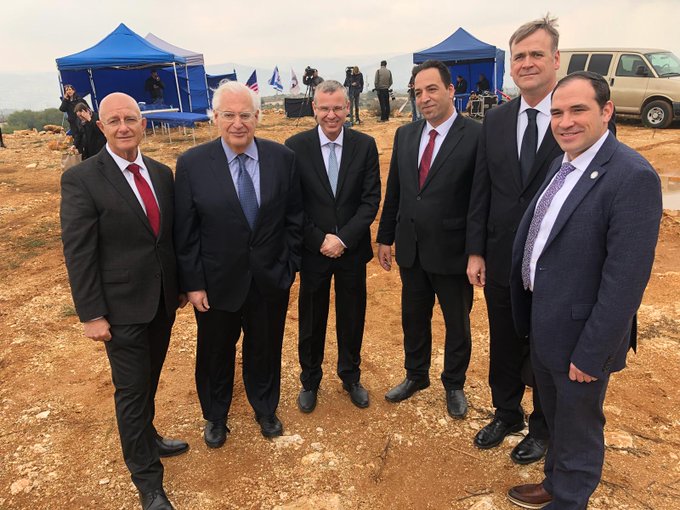Tamara Nassar
Israel’s Maaleh Adumim settlement east of Jerusalem. Israel’s plan to expand colonies in the area would sever the northern and southern parts of the occupied West Bank, foreclosing the possibility of a contiguous Palestinian state.
Reuters
Prime Minister Benjamin Netanyahu vowed on Tuesday to build 3,500 homes for Jewish settlers in the so-called E1 area, east of Jerusalem in the occupied West Bank.
It is the last large open space between Jerusalem, to the west, and Israel’s huge Maaleh Adumim colony, to the east, where almost 40,000 settlers live.
Successive Israeli governments have pledged to build in E1, but have faced international pressure not to do so.
If Israel does build settlements there it will isolate the northern and southern parts of the occupied West Bank from each other, foreclosing the possibility of a contiguous Palestinian state.
E1 falls within Area C, the 60 percent of the occupied West Bank which under the 1993 Oslo accords remains under full Israeli control.
Closing off any possibility of a Palestinian state may be precisely why Netanyahu is moving ahead, secure that he will enjoy support from the Trump administration.
“I have given instructions to immediately publish for deposit the plan to build 3,500 housing units in E1,” Netanyahu said at a Jerusalem conference less than a week before the third round of Israeli elections in a year.
“This had been delayed for six or seven years.”
Israel’s construction of settlements on occupied territory is a war crime that the prosecutor of the International Criminal Court recently decided must be formally investigated.
Previous opposition
The plan to colonize E1 was first championed by Prime Minister Yitzhak Rabin in 1994, soon after Israel signed the Oslo accords with the Palestine Liberation Organization.
Six of Rabin’s successors endorsed it.
Netanyahu made a similar pledge in 2012, announcing plans to build about 3,000 housing units in E1.
The Obama administration publicly and privately criticized Netanyahu’s comments at the time out of concern for the already moribund two-state solution.
The European Union has also repeatedly warned Israel not to build in E1.
But while pressure has delayed specific projects, these governments have taken no practical measures to stop Israel’s aggressive colonization throughout the West Bank.
In recent days, various governments have issued ritual criticism of Israel’s colonization. But these statements appear no more likely to be followed by action that would impose a cost on Israel.
Netanyahu has more leverage than ever, knowing that he can safely ignore toothless European criticism, while counting on full US support.
“It used to be that [Netanyahu] would get away with all sorts of settlement projects elsewhere so long as he didn’t touch E1,” settlement watchdog Peace Now stated.
“With the current US administration, he can have his cake and eat it too.”
The Middle East “peace” plan recently released by the Trump administration greenlights Israel’s annexation of settlement blocs and large swaths of land in the occupied West Bank.
Annexation committee
Netanyahu made his new announcement a day after he met with members of a joint US-Israeli committee that is mapping out areas of the occupied West Bank whose annexation by Israel the Trump administration will bless.
The prime minister took the team on a tour of Ariel, an Israeli settlement in the central occupied West Bank.
“For the mapping process, one must consider every valley, every section, every nook and every line. This is serious. We are determining here lines that have historic implications,” Netanyahu said.
He added that Israel could assert its sovereignty over the areas immediately, and US recognition would follow.
Israeli journalist Tal Shalev posted a picture of what she called the “US-Israel annexation mapping committee” on Twitter.
The group includes US ambassador to Israel David Friedman and Israeli tourism minister Yariv Levin.
Annexation of Hebron
Meanwhile, Tuesday marked 26 years since American Jewish settler Baruch Goldstein walked into the Ibrahimi mosque in the occupied West Bank city of Hebron and massacred 29 Palestinian men and boys during Ramadan prayers.
Now, Netanyahu is pledging to annex the sacred site, known to Jews as the Tomb of the Patriarchs, as well as Jewish settlement blocs in and around the Palestinian city.
“We will apply Israeli sovereignty over Kiryat Arba and the Jewish community in Hebron, including the Tomb of the Patriarchs and the roads that lead to it,” Netanyahu reportedly said during the inauguration of Nofei Cramim, a new settlement with 210 homes.
Netanyahu said he authorized a wheelchair-accessible elevator to the religious site.
In an attempt to whitewash the planned annexation of the area, he called it “a humanitarian act and an act of sovereignty.”
Naftali Bennett, Israel’s defense minister, said that Israel without sovereignty over the religious site is akin to the United States without the Lincoln memorial.
“I strongly oppose the giving of even one inch of land to the Arabs,” he added.
Dividing Jerusalem
On Monday, the Israeli government issued tenders for the construction of more than 1,000 housing units in the Givat Hamatos settlement south of Jerusalem.
Expansion of the settlement was put on hold due to opposition from the Obama administration in 2014.
If implemented, the expanded colony would separate the Palestinian neighborhoods of Beit Safafa and Sharafat from occupied East Jerusalem.
The two neighborhoods have already suffered severe harm due to Israeli settlement construction in the past.








No comments:
Post a Comment